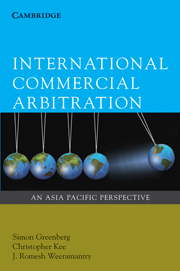Book contents
- Frontmatter
- Contents
- Foreword
- Preface
- Table of Cases
- Table of Statutes
- 1 Introduction to international arbitration and its place in the Asia-Pacific
- 2 Law governing the arbitration and role of the seat
- 3 Applicable substantive law
- 4 Arbitration agreement
- 5 Arbitral jurisdiction
- 6 The arbitral tribunal
- 7 Procedure and evidence
- 8 The award
- 9 The award
- 10 Investment treaty arbitration
- Appendix 1 Asia-Pacific arbitral institutions at a glance
- Appendix 2 Selected arbitral institutions
- Appendix 3 List of UNCITRAL Model Law countries
- Appendix 4 List of parties to the New York Convention 1958
- Appendix 5 Selected list of Asia-Pacific arbitration legislation and instruments
- Glossary
- Index
3 - Applicable substantive law
Published online by Cambridge University Press: 05 June 2012
- Frontmatter
- Contents
- Foreword
- Preface
- Table of Cases
- Table of Statutes
- 1 Introduction to international arbitration and its place in the Asia-Pacific
- 2 Law governing the arbitration and role of the seat
- 3 Applicable substantive law
- 4 Arbitration agreement
- 5 Arbitral jurisdiction
- 6 The arbitral tribunal
- 7 Procedure and evidence
- 8 The award
- 9 The award
- 10 Investment treaty arbitration
- Appendix 1 Asia-Pacific arbitral institutions at a glance
- Appendix 2 Selected arbitral institutions
- Appendix 3 List of UNCITRAL Model Law countries
- Appendix 4 List of parties to the New York Convention 1958
- Appendix 5 Selected list of Asia-Pacific arbitration legislation and instruments
- Glossary
- Index
Summary
Introduction
This chapter concerns the identification of the law that applies in an international arbitration. Various laws may apply to different aspects of the dispute.
After providing an overview of the types of choice of law issues that arise in international arbitration (Section 2), the remainder of this chapter focuses on the law applicable to the merits or substance of the parties' dispute. It first examines how an arbitral tribunal should determine the applicable law (Section 3). It then considers other issues such as mandatory laws, which apply regardless of the otherwise applicable substantive law (Section 4), how an arbitral tribunal should determine the content of the applicable law (Section 5), the compulsory application of the terms of the contract and trade usages (Section 6), the possibility of applying national rules of law or the lex mercatoria (Section 7), and finally the possibility for international arbitrators to decide cases based on principles of fairness and justice without reference to law (Section 8).
The treatment of applicable law issues in investment arbitrations under the ICSID Convention is completely different from international commercial arbitration. It is addressed in Chapter 10, Section 4.5.
Types of conflict of law issues in international arbitration
Determining the applicable law in an international litigation matter (i.e. before a state court) can be very complex, yet seductively interesting from an academic perspective.
- Type
- Chapter
- Information
- International Commercial ArbitrationAn Asia-Pacific Perspective, pp. 96 - 143Publisher: Cambridge University PressPrint publication year: 2010

